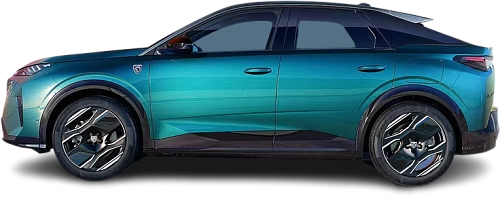USA EV Comparison: BYD Seal U Design vs Peugeot e-3008 73 kWh FWD
Struggling to Decide? Let AI Help!
Your AI Summary Is Ready!
General Info
While both vehicles are currently in production, they are not sold in the United States.
The two vehicles share the same body style: SUV.
| Property | BYD Seal U Design | Peugeot e-3008 73 kWh FWD |
|---|---|---|
| Years of Production | 2024-… | 2024-… |
| Current Status | Produced | Produced |
| Country of Manufacture | China | France |
| Body Style | SUV | SUV |
| Market Availability | EU | EU |
| GCC Score | 6.3 | 6.3 |
Range and Efficiency
While the BYD Seal U Design (2024-...) offers a longer real-world range and a bigger battery, it is less energy-efficient than the Peugeot e-3008 73 kWh FWD (2024-…).
| Property | BYD Seal U Design | Peugeot e-3008 73 kWh FWD |
|---|---|---|
| Range (WLTP) | 311 mi | 326 mi |
| Range (GCC) | 264 mi | 255 mi |
| Battery Capacity (Nominal) | 89 kWh | 77 kWh |
| Battery Capacity (Usable) | 87 kWh | 73 kWh |
| Efficiency per 100 mi | 33 kWh/100 mi | 28.6 kWh/100 mi |
| Efficiency per kWh | 3.03 mi/kWh | 3.49 mi/kWh |
| Range and Efficiency Score | 6.3 | 7 |
Charging
Both vehicles utilize a standard 400-volt architecture.
The Peugeot e-3008 73 kWh FWD (2024-…) offers faster charging speeds at DC stations, reaching up to 160 kW, while the BYD Seal U Design (2024-...) maxes out at 140 kW.
Both vehicles are equipped with the same on-board charger, supporting a maximum AC charging power of 11 kW.
| Property | BYD Seal U Design | Peugeot e-3008 73 kWh FWD |
|---|---|---|
| Max Charging Power (AC) | 11 kW | 11 kW |
| Max Charging Power (DC) | 140 kW | 160 kW |
| Architecture | 400 V | 400 V |
| Charge Port | CCS Type 2 | CCS Type 2 |
| Charging Score | 6.5 | 6.5 |
Performance
Both vehicles are front-wheel drive.
Although the BYD Seal U Design (2024-...) has more power, the Peugeot e-3008 73 kWh FWD (2024-…) achieves a faster 0-60 mph time.
| Property | BYD Seal U Design | Peugeot e-3008 73 kWh FWD |
|---|---|---|
| Drive Type | FWD | FWD |
| Motor Type | PMSM | PMSM |
| Motor Power (kW) | 160 kW | 157 kW |
| Motor Power (hp) | 215 hp | 211 hp |
| Motor Torque | 243 lb-ft | 253 lb-ft |
| 0-60 mph | 9.2 s | 8.4 s |
| Top Speed | 109 mph | 106 mph |
| Performance Score | 3.4 | 3.5 |
Dimensions
The BYD Seal U Design (2024-...) is longer, but has a similar width and height to the Peugeot e-3008 73 kWh FWD (2024-…).
Both models have similar wheelbase lengths.
| Property | BYD Seal U Design | Peugeot e-3008 73 kWh FWD |
|---|---|---|
| Length | 188.4 in | 178.7 in |
| Width (with Mirrors) | 82.1 in | 74.6 in |
| Width (w/o Mirrors) | 74.4 in | 74.4 in |
| Height | 65.7 in | 64.6 in |
| Wheelbase | 108.9 in | 107.8 in |
Cargo and Towing
The BYD Seal U Design (2024-...) features a larger trunk, but the Peugeot e-3008 73 kWh FWD (2024-…) offers greater maximum cargo capacity when the rear seats are folded.
Neither car is equipped with a frunk (front trunk).
The BYD Seal U Design (2024-...) is better suited for heavy loads, offering a greater towing capacity than the Peugeot e-3008 73 kWh FWD (2024-…).
| Property | BYD Seal U Design | Peugeot e-3008 73 kWh FWD |
|---|---|---|
| Number of Seats | 5 | 5 |
| Curb Weight | 4733 lb | 4592 lb |
| Cargo Volume (Trunk) | 19.5 ft3 | 18.4 ft3 |
| Cargo Volume (Max) | 50.9 ft3 | 52.3 ft3 |
| Cargo Volume (Frunk) | - Cargo Volume (Frunk) | - Cargo Volume (Frunk) |
| Towing Capacity | 2866 lb | 2756 lb |
| Cargo and Towing Score | 7.2 | 6.7 |




